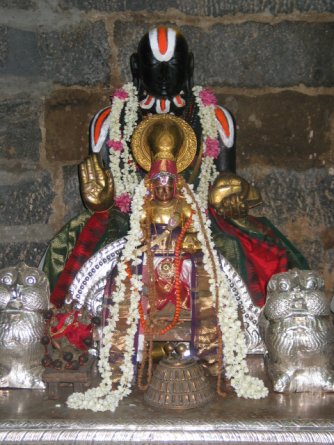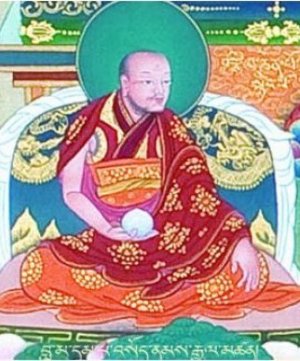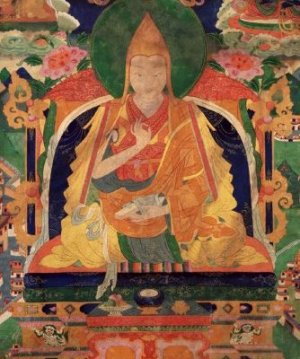| Library / Biographies |
Vedānta Deśika Biography

Swamy Śri Vedānta Deśikan in Kanchipuram.Vedānta Deśika was born in 1268 CE at Kāñcīpuram in Tamil Nadu as the only son of Anantasīri and Totāramma, a family closely linked to Śrī Vaiṣṇavism. They named him Veṅkatanātha in honor of Veñkateśvara, the god of Tirumala-Tirupati.
His uncle, Ātreya Rāmānuja1 was his preceptor and had a profound influence on his education. Vedānta Deśika became an erudite scholar by the age of twenty-one. He was married to Tirumaṅgai who proved to be an ideal wife, fully cooperating with the husband in his spiritual aspirations.
Next to Rāmānuja, Vedānta Deśika was the chief architect who established the Viśiṣṭādvaita Vedānta on a firm foundation and shaped the Śrīvaiṣṇava sect into a well-knit movement.
Throughout his life Vedānta Deśika worked hard and vigorously to propagate Rāmānuja’s philosophy and religion through discourses, disputations with other schools and writing books. He was a prolific writer, whose writings exceed a hundred treatises and compositions.
He toured the country extensively especially visiting the places connected with Vaiṣṇavism. He was the Acārya of the pontifical seat at Kāñcīpuram, one of the 74 established by Rāmānuja.
Vedānta Deśika introduced some reform in the Vaiṣṇava faith. This gave rise to the formation of two sects, one called the Northern School (Vadakalai, based on the Sanskritic tradition) and the Southern School (Thenkalai, based more on Tamil slokas than Sanskrit, and giving more emphasis on worship of Vishnu.) The Vadakalais are followers of Rāmānuja and Vedānta Deśika.
Swami Desika died in 1369, aged 101 years, while his disciples chanted Tiruvoimozhi and Upanishads. He attained Paramapadam.2
His disciples of most importance were his son Nainārācārya, also called Kumara Vedānta Deśika, who wrote many Vedantic works, and Brahmatantra Svatantra Jiyar, a saṅiyāsin who established the Parakāla Maṭha, one of the important monasteries of the Śrīvaiṣṇava school.
Writings
Sanskrit Hymns
1. Abheeti Sthavam
2. Achyuta Sathakam
3. Ashtabuja Ashtakam
4. Bhagavad Dhyaana Sopaanam
5. Bhoo Sthuthi
6. Dasaavataara Stotram
7. Dayaa Sathakam
8. Dehaleesa Sthuthi
9. Devanaayaka Panchaasath
10. Garuda Dhandakam
11. Garuda Panchaasath
12. Godhaa Sthuthi
13. Gopaala Vimsathi
14. Hayagriva Stotram
15. Kaamaasika Ashtakam
16. Nyaasa Dasakam
17. Nyaasa Tilakam
18. Nyaasa Vimsathi
19. Paramaartha Sthuthi
20. Raghu Veera Gadhyam (aka) Mahaveera Vaibhavam
21. Saranaagathi Deepikai
22. Shodasa Aayudha Stotram
23. Sree Sthuthi
24. Sudharsana Ashtakam
25. Vairaaghya Panchakam
26. Varadaraaja Panchaasath
27. Vegaa Sethu Stotram
28. Yathiraaja Sapthadhi
Poetry
1. Subjashithaanivi
2. Yaadhavaabhyudhayam
3. Paduka Sahasram
4. Hamsa Sandhesam
5. Samasya Sahasri (Luptham-Lost)
Tamil Hymns
1. Amrita Ranjani
2. Adhikaara Sangraham
3. Amritaaswaadhini
4. Parama Padha Sopaanam
5. Para Matha Bhangam
6. Mei Vratha Maanmiyam
7. Adaikkalap Pathu
8. Artha Panchakam
9. Sri Vaishnava Dhinasari
10. Tiruchchinna Maalai
11. Panniru Naamam
12. Tiru Mantira Churukku
13. Dvaya Churukku
14. Charma Sloka Churukku
15. Gitaartha Sangraham
16. MumManik Kovai
17. Navaratna (aka Navamani) Maalai
18. Prabhandha Saaram
19. Aahaara Niyamam
20. Pandhu (Luptham-Lost)
21. Kazhal (Luptham-lost)
22. Ammaanai (Luptam-Lost)
23. Oosal (Luptham-Lost)
24. Yesal (Luptham-Lost)
Drama
1. Sankalpa Suryodhayam
Esoteric Texts
1. Sat Sampradaaya Pari Suddhi
2. Tattva Padhavi
3. Rahasya Padhavi
4. Tattva Navaneetham
5. Rahasya Navaneetham
6. Tattva Maatrukai
7. Rahasya Maatrukai
8. Tattva Sandhesam
9. Rahasya Sandhesam
10. Rahasya Sandhesa Vivaranam
11. Tattva Ratnaavali
12. Tattva Ratnaavali Prathipaadhya Sangraham
13. Rahasya Ratnaavali
14. Rahasya Ratnaavali Hridhayam
15. Tattva Thraya Sulakam
16. Rahasya Thraya Sulakam
17. Abhaya pradhaana saaram
18. Rahasya sikhaamani
19. Anjali vaibhavam
20. Pradhaana sathakam
21. Upakaara sangraham
22. Saara Sangraham
23. Muni Vaahana Bhogam
24. Madhura Kavi Hridhayam (Luptham- Lost)
25. Parama pada sopaanam
26. Para matha bhangam
27. Hasthigiri mahaathmyam
28. Rahasya thraya saaram
29. Saara Saaram
30. Virodha Parihaaram
31. Nigama Parimalam (Lutham-Lost) 3
32. Thiru Mudi Adaivu (Luptham- Lost)
Vedanta Texts
1. Tattva Mukthaa Kalaapam
2. Adhikarana Saaraavali
3. Satha Dhushani (aka) Satha Doshaani)
4. Nyaaya Parisuddhi
5. Seswara Mimaamsa
6. Mimaamsa Paaduka
7. Nikshepa Raksha
8. Sat Charitha Raksha- containing (i) Sudharsana Paancha Janya Vidhi, (ii) Oordhva Pundra Dhaarana Vidhi, (iii) Bhagavan Nivedhitha Upayoga Vidhi
9. Rahasya Rakshaa
10. Dramidopanishad Taatparya Ratnaavali (A commentary on Nammalwar's Tiruvoimozhi)
11. Dramidopanishad Saara (A shorter version of above)
Commentaries
1. Sarvaartha Siddhi
2. Tattva Teekha
3. Chatus Slokee Bhashya
4. Stotra Ratna Bashya
5. Gitaartha Sangraha Raksha
6. Taatparya Chandrika
7. Isaavaasyopanishad
8. Vedaartha Sangraha (Luptam-Lost)
9. Rahasya Raksha (aka) Gadhya Thraya Bashya)
10. Adhikarana Darpanam
Rituals
1. Bhagavad Aaraadhana Vidhi
2. Yagnopaveetha Prathishta
3. Hari Dina Tilakam
4. Vaishnava Dinasari
Miscellaneous Texts
1. Bhoogola Nirnayam
2. Silpaartha Saaram
3. Stheya Virodham
4. Chakaara Samarthanam
5. Vaadhi Thraya Khandanam
6. Vaisvadeva Kaarika
7. Guru Paramparaa Saaram
8. Dathi Panchakam
9. Yamaka Ratnaakaram
10. Daasa Deepikaa Nigantu
11. Vedaartha Sangraha Vyaakhyaanam
12. Saara Dheepam
13. Tattva Sikhaamani (Luptham-Lost)
Sources:
https://en.wikipedia.org/
• https://iep.utm.edu/venkatan/
• http://www.hindupedia.com/en/Ved%C4%81nta_De%C5%9Bika
• https://www.dlshq.org/download/hinduismbk.htm
• https://www.wisdomlib.org/definition/paramapadam
Footnotes
1. Ātreya Rāmānuja is traditionally believed to have been born in Kañcipūram in the year 1220, the fourth in a lineage of disciples started by Rāmānuja himself.
2. Paramapadam or Vaikuntam (Vaikuṇṭha) refers to one of the 108 Vaiṣṇava Divya Desam (divyadeśas or divyasthalas), located in the topographical division of “heaven”, according to the 9th century Nālāyirativviyappirapantam (shortly Nālāyiram).—Tradition would record the Vaiṣṇava divyadeśas or divyasthalas are 108.
The divyadeśa is a base of the cult of Viṣṇu in Viṣṇuism [Vaiṣṇavism] tradition. The list of 108 [viz., Paramapadam] seems to have reached maturation by about the early 9th century CE as all the deśas are extolled in the hymns of the twelve Āḻvārs.





